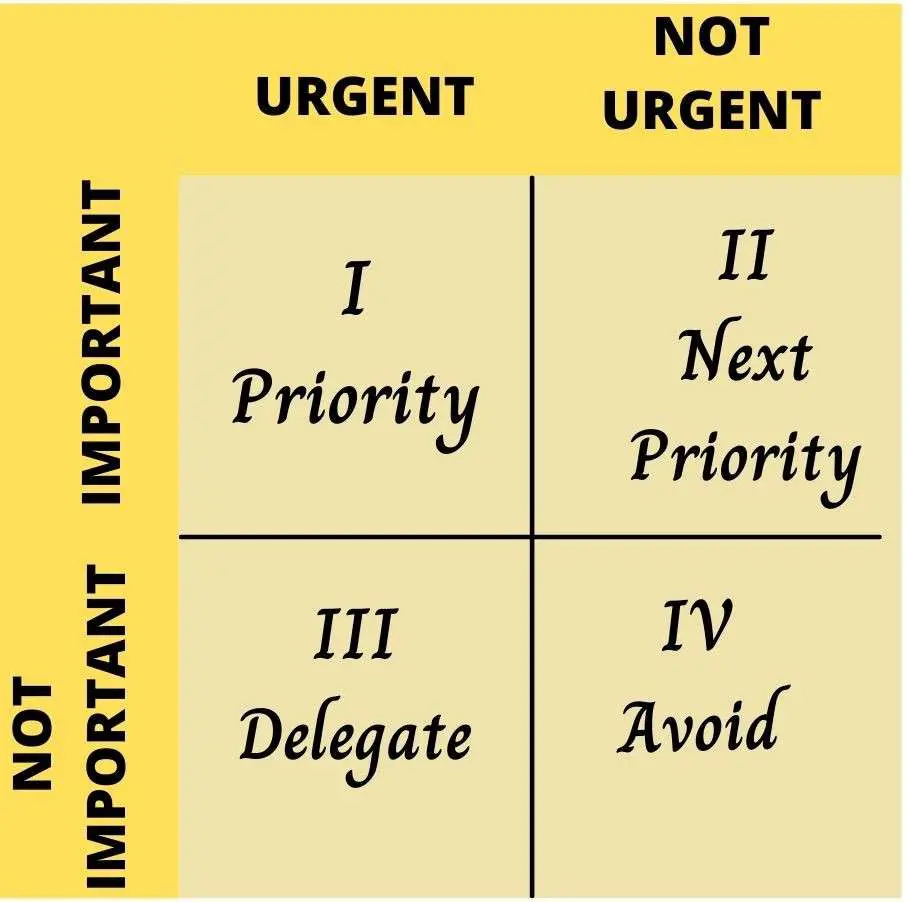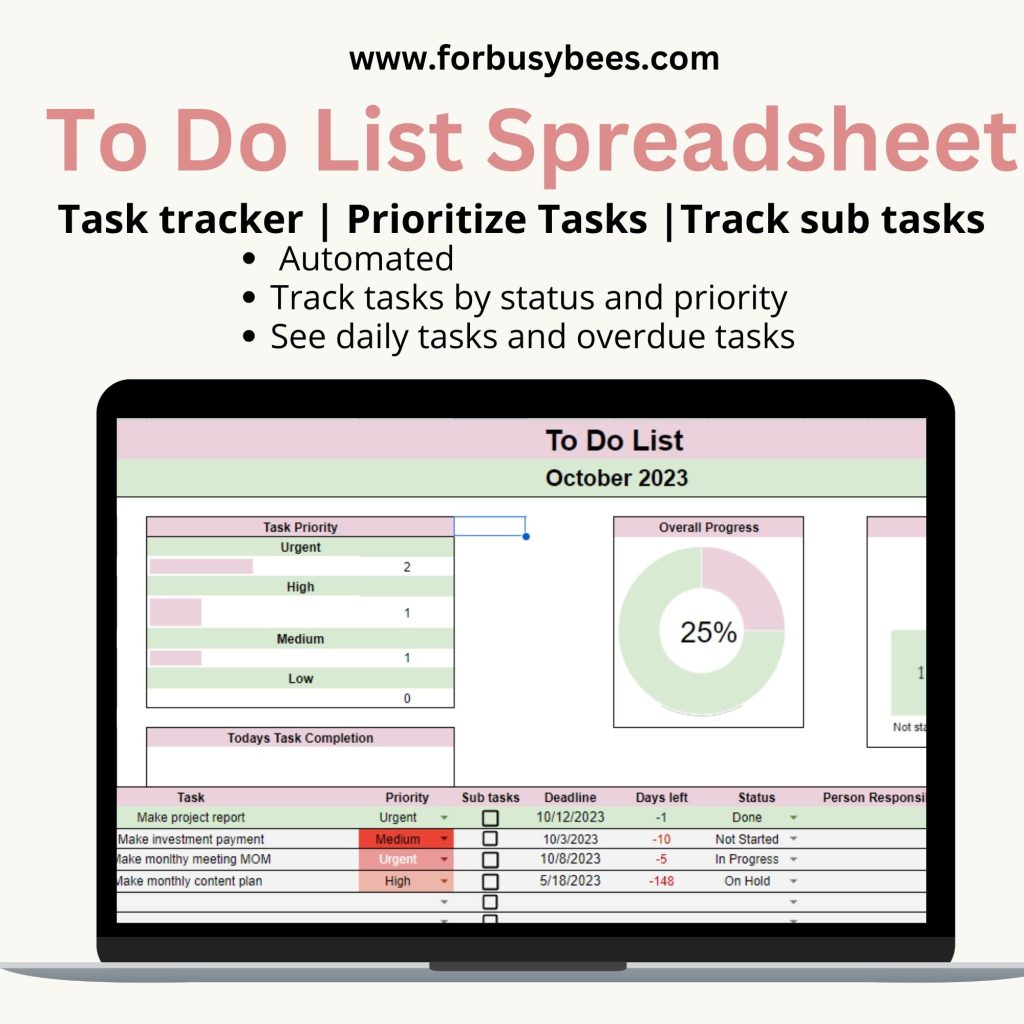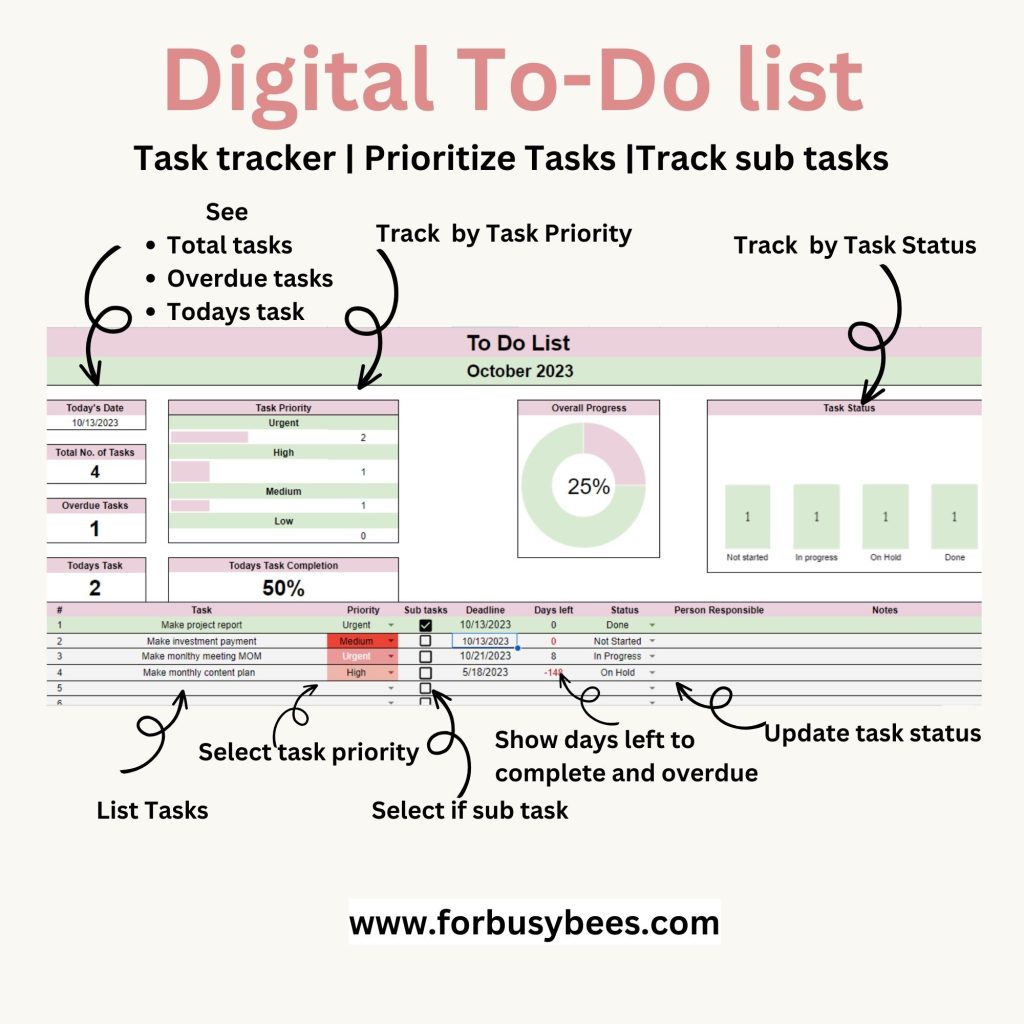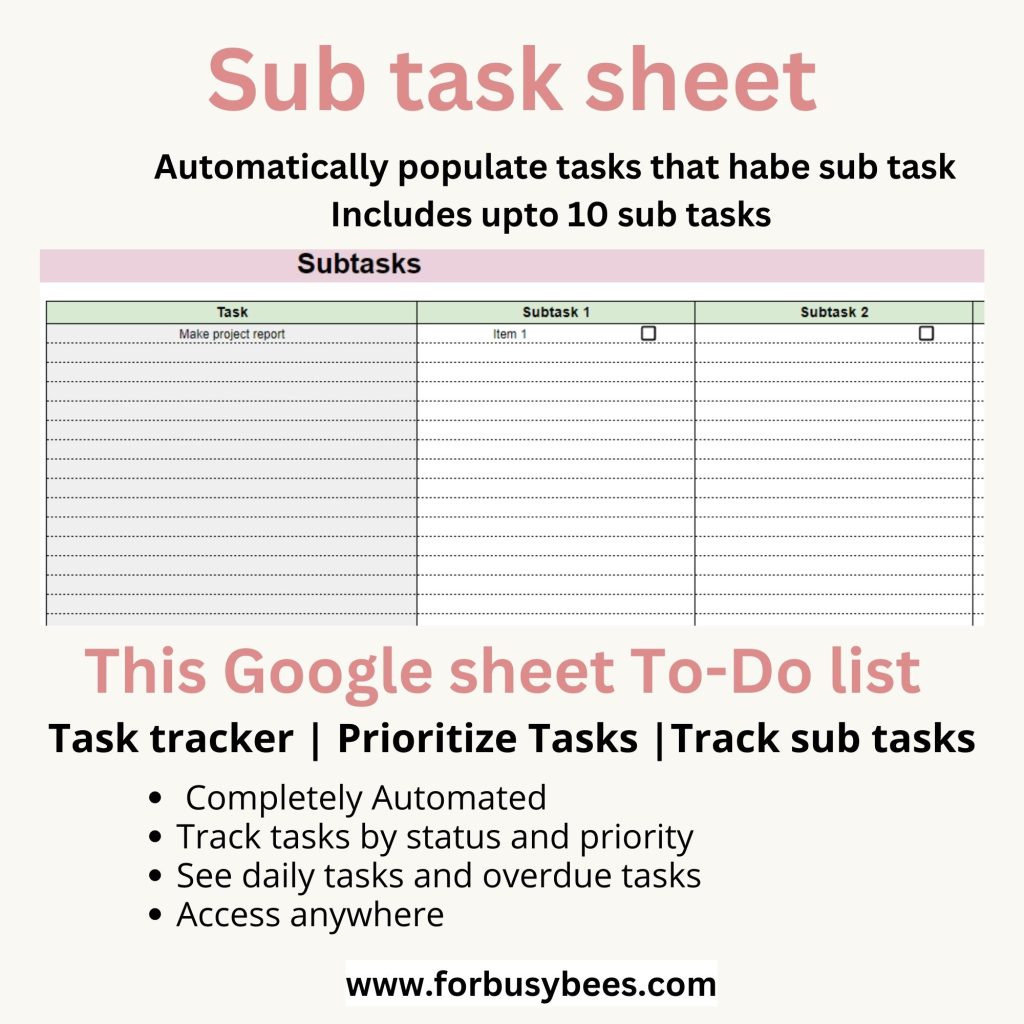How to prioritize work tasks

Prioritize your work, this is the most common suggestion to beat overwhelm and the long list of tasks. But how to prioritize work tasks? Is not discussed much. So, I did research to find a simple way to prioritize tasks, tried them, and found the one that suited me.
In this post, I’m going to explain all the things I have learned about prioritizing work:
- Steps to prioritize work
- Different techniques to prioritize work
- How I prioritize work
Let’s look at how it’s done …
Why prioritize work tasks
Each day at work and in life we have many tasks to attend from sending emails to making project reports, there are big and small tasks.
When you prioritize task:
- You select the right task that brings you closer to success.
- You focus on work that is important.
- You avoid the consequences of not attending urgent work.
- Reduce overwhelm.
- Deliver your accountable task better.

Steps to prioritize work
Following are steps to help you prioritize work tasks easily
Step 1:Get clear with your goals
Before starting with the prioritization of your work, you need to be clear with your goals.
Identifying your goals make it easier for you to find tasks that align with your goals and the aspiration you are desire.
You can plan short-term and long-term goals. If you need help with goal setting and planning for long-term goals you can read Goal setting and goal planning for the New Year, that’s actually effective.
However, just having long-term goals is not sufficient you need to break down your long-term goals into short-term goals to achieve them.
Having short-term goals well-defined makes the prioritization process easier. To know how to make monthly goals read Monthly Goal Planning for Balanced Life under 30 min.
Being clear on goals is important as with routine tasks and work, you tend to forget about your goals, including goals in the process of prioritization ensures your goals are not missed in the hustle of work.
Step 2: Find your accountability
At work, many kinds of tasks need to take care of and often they all seem very important but you need to identify tasks you are accountable for to make prioritization easier for you.
An easy way to find your accountability is by referring to your performance matrix. Every job profile has key deliverables associated with the work. They are often called a success matrix or Key performance indicators (KPI).
You should understand your performance indicators and identify the tasks that drive you to achieve these indicators. In case you do not have such a definition for your role. You can reach your supervisor and find them. This will help you to work towards things that really matter.
For example, if you work at a customer support team your key deliverables can be customer satisfaction, the amount of time you take to close the issue and you will be accountable for these tasks. Hence you should prioritize them over others.
Step 3: Make a task list
This is something I thoroughly believe. Always, always, always have a running To-Do list. Each day you will come across many tasks at work, home, life. Note it down immediately at one place. Don’t fall for the thought that you will remember it, coz you will not.
Task will keep adding and soon you will forget the older ones. Also, when you don’t write it will keep running at the back of your mind and you will not be able to focus on your work.
Maintaining a running To-Do list will reduce your effort in prioritization of work and planning. I will explain it later in the post.
If you want to make a good To-Do list read 10 Ways To Make An Effective To-Do List.
To prioritize your tasks and track your tasks better use below task prioritizing To -Do list, it will give you complete details on your tasks in a glance.
Task Prioritizing To-Do List
$6
Organize your tasks and never miss a task with that task tracker
- Organize all your tasks in one place
- Prioritize Tasks as urgent, high, medium, and low
- Track sub-tasks
- See Total tasks, Overdue tasks, and Today’s tasks at a glance.
- Track task by status of work
- See days left to complete task or overdue
- Completely automatic and access anywhere
Step 4: Prioritize work
Finally, the last step is the prioritization of work. Or you can call the previous step were preparation to prioritize work.
When I started to learn more about how to prioritize work tasks, my research mostly found the below 3 methods as the most commonly suggested prioritization techniques. Let’s see a brief for these work prioritization strategies.

Eisenhower Matrix to prioritize work tasks
The Eisenhower Matrix is a strategy by Eisenhower, the 34th President of the United States. This technique involves dividing your work into 4 categories based on their urgency and importance.
These 4 categories are:
Urgent and important (I Quadrant)
This quadrant includes all the tasks that are urgent and important for you. These need to be addressed immediately and should be your first priority.
These may include your key deliverable for which you are accountable along with unforeseen urgent matters. You should also take into consideration the impact or consequences if the task is not addressed and add them to the priority if the consequences are severe.
Important, but not urgent (II Quadrant)
This includes all the tasks that are not urgent but are important and should be your second priority. These include mostly task that you are accountable for and also tasks that are aligned with your personal and career goals.
Tasks that belong in this quadrant are of high value to you and may need more time to complete but would be more rewarding.
Urgent, but not important (III Quadrant)
All the urgent but unimportant tasks such as those that are not gonna add value to you and are not your key deliverable belong to the third category.
This can be helping your co-worker or tasks that do not need your expertise. These tasks can be delegated to others when possible. Also, consider automating repetitive tasks.
Neither urgent nor important (IV Quadrant)
All task that are neither urgent and not important belongs to the fourth quadrant. These are mostly tasks that are not your key deliverable they are neither urgent to anybody and probably if not performed may not cause any impact.
However, when you place any task in the last quadrant you should re-evaluate for urgency it may result later or any possible impact. All these tasks can be eliminated without any adversity.
Ivy Lee Method to prioritize work tasks
The Ivy Lee method is based on prioritizing on a daily basis. This method involves focusing on 6 tasks for the day. So basically from your To-Do list, you find 6 tasks for the day. Next, you need to prioritize among these 6 tasks and can list them in order of priority. The first task will be most important followed by others and the 6th task will be least important relative to the others.
You should just focus on one task and should not move to the next task till the time the previous one is completed.
Any task that could not be completed for the day will be moved to the next day.
ABCDE method to prioritize work tasks
The ABCDE method for prioritization starts with your To-Do list. All the tasks are prioritized as follow
A task
All the tasks that are important are identified as A. These are tasks that have high value, are your key deliverables or if not attended can result in severe consequences.
If there are multiple A tasks you can define them as A1, A2, etc.
B task
The B task can be your urgent task that do not have importance, these task if not done can result in mild consequences. These can be commitments you have made or things that may cause inconvenience at work if not attended on time. This can also be preparation for an important A task.
For example, if you have a meeting the next day, you can define meeting preparation for the next day as B.
C Tasks
These are all the tasks that are neither important nor urgent. There may be no consequences if these tasks are not attended. These mostly work that can be an opportunity to improve work or be proactive. These tasks can be attended after finishing the A and the B tasks.
D Tasks
All the tasks on your To-Do List that can be performed by others are assigned as D tasks and are delegated to others. Delegating tasks to others will allow working more effectively towards the important tasks.
E tasks
Any task on your To-Do list that does not add any value to you does not align with your goals, and is not accountable to you can be eliminated.
So these are the most common prioritization technique.
How I prioritize work tasks
I have tried to follow each method and I have finally found that a hybrid of the Ivy Lee method and ABCDE method best suits me.
- To my To-Do list, I write ABCDE you also highlight them with different colors.
- Next at the end of the day, I write 6 tasks for the next day in the order of 1 to 6 as per the lvy Lee method.
- I add a maximum of 3 A tasks. 2 B tasks and 1 C task. I also note the D task to ensure I delegate or follow up for the delegated task.
- Many times I may have less than 6 tasks if my A task is intense and would be time-consuming.
- I also include attending meetings also as a task since they certainly take time and involve work around the meeting.

Tips to prioritize work
Lastly I would like to share some tips to help you prioritize your work effectively with ease.
Tip 1: Prioritizing competing priority
You may come across a situation when you will have two tasks that are competing on priority. Both may feel equally important and urgent to you.
In such a case consider not just the importance and urgency of work but also consider the time required to complete the work and the consequences it may have.
For example, Task X and Task Y are equally urgent and important but the time required to complete Task X is more than Y, in such a case it will be good to take Task X first as it can be addressed faster. Taking task Y may delay completing task X and may result in consequences.
Tip 2: Validate prioritization
In case of doubt or to review the prioritization is effective to try to seek feedback and reflect back on your past month to understand if there were crises or situations when you had not handled your work well.
P.S. You can know more about monthly reflection by reading How to do Monthly reflection quickly
You can also speak to your supervisor to understand the prioritization followed is in line with their expectation.
Tip 3: Learn to say No
Many times co-workers seek help or we are delegated work that is urgent for others but not for you. Learning to say no to others is difficult but required at some point in life.
You can always reply politely to others that you have important work to attend to, and you can help them some other day or will not be able to help them.
Tip 4: Timebox prioritization
I prefer to do prioritization of work on a weekly basis and just fine-tune it on a daily basis. Timebox time of 15-20 minutes, otherwise you may spend way more time over prioritization and may overcomplicate the decision.
P.S. if you want to know more about timeboxing to improve your productivity read Timeboxing at work: An effective way to get the most done.
Tip 5: Keep a running To-Do List
Prioritization of work becomes easy and less time-consuming if you have a running To-Do List. It is basically your task list that has all the tasks in one place and you keep adding to it a new task as and when you find one. This ensures everything is in one place and you directly start with prioritization of work.
Frequently Asked Questions

The last thing you need to know about prioritizing work task
- So this is how you prioritize work tasks. The steps shared in the post will help you prioritize with ease and help you build a consistent practice of prioritization of work.
- Depending on the type of work you perform and your work style you can decide on the prioritization technique that best suits you. You should also give a try to the prioritization method that I follow and have shared in the post, it is something that has worked well for me.
- You can give a try to different methods shared and make something that is suitable to you.
Hope you find this helpful. Next time if you are in a dilemma looking at your long task list, give a shot at these steps to prioritize work. And get control of your tasks with this To-Do list that easily help you prioritize work,










2 Comments
Comments are closed.